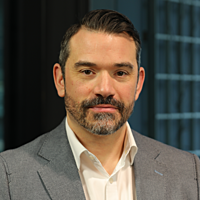Product ready and cash rich, Catapult targets $1 billion in annual contract value
Please note, this interview was filmed Tuesday 18 November 2025
Although the Catapult (ASX: CAT) share price has come under pressure in recent weeks, you wouldn’t know it speaking to CEO Will Lopes. He isn’t distracted by the market’s wobble or the noise around growth stocks more broadly. Instead, he is focused squarely on what he can control: building a stronger, broader, more profitable sports-technology platform.
What stood out in CAT's latest set of numbers is the balance between revenue momentum and margin expansion. Subscription ACV (annual contracted revenue) rose 19% year-on-year, yet earnings grew far faster. Free cashflow for the half already matches all of last year’s. And Catapult’s rule of 40 score - shorthand for the sustainability of growth - has jumped to a record 33%. Six months on from our last conversation, Lopes is still talking about growth, but the ambition now feels more concrete and more grounded in the economics of the business.
That ambition is perhaps best captured in something he told me during this conversation:
“Our goal has always been, if we get to around 6,000-8,000 clients giving us somewhere between a $100,000-150,000 annually, we'll be well on our way to a billion dollars of ACV.”
It’s a big number, but the strategy behind it is clear: expand the number of pro teams on the platform, increase the share of wallet per team, and keep driving operating leverage through cloud-based hardware, cross-sell, and a growing use of AI.
For investors, the question isn’t whether Catapult can grow; it’s whether it can grow profitably and consistently. In the conversations above, we unpack the key products, acquisitions, financial metrics and strategic signals shaping the next phase of Catapult’s journey.
.png)
INTERVIEW SUMMARY
Results that blend growth and profitability
Lopes characterises the half as confirmation that Catapult is now a profitable growth story. Contracted subscription ACV rose 19% year on year, while earnings grew much faster.
“We actually have seen our management EBITDA, which is what we use for our profit metric, grow 50% year-over-year, and that is basically driving our operating profit margins at 14%,” he says.
That mix has lifted the rule of 40 score to 33%, which he calls “a record high.”
He links the improvement to discipline on both sides of the cost base. Variable costs are targeted at “no more than about 45% per dollar of revenue,” while fixed costs, mainly administration and R&D, are expected to grow only “somewhere between 5-10% annually” as Catapult benefits from a scalable platform and increasing use of AI in development and support.
Solving the scouting bottleneck with impact
The headline strategic move in the period was the acquisition of IMPECT, a scouting solution for global soccer. It plugs a long-standing gap in Catapult’s video analysis stack. Outside the very top clubs, Lopes notes, “scouting in global soccer in many ways is 95% of where revenue is made,” with about US$10 billion of transfer fees paid last year alone.
A rival had enjoyed an advantage by bundling video with an incumbent scouting tool, while Catapult had been forced either to integrate around that product or consider building its own over time.
“IMPECT really came in as something that we're very, very excited about, both from the technology that it's bringing, and our ability to now combine it with our video analysis solution,” he says.
The new bundle of video and scouting turns cross-sell into a much larger revenue opportunity, so that when Catapult sells into an existing wearable client, “that bundle combined altogether is now not only 2x, it's probably like 5x what we were acquiring from a wearable.”
Clubs that had told Catapult, “If you could solve that, we would be delighted,” are already engaging, creating what Lopes calls “quite a bit of a pipeline.”
Perch, Vector 8 and a more complete view of the athlete
Perch, acquired about five months ago, extends Catapult’s reach from the field into the gym. Lopes describes it as “Catapult inside the gym,” capturing strength and conditioning data in the weight room and linking it directly to on-field performance.
“The combination of what we do and what they were doing now gives us probably the most complete picture, anywhere, of what an athlete's performance looks like,” he says.
Perch was already well established in North American football; Catapult has since begun signing sizeable deals in Europe, moving into Asia and expanding into new sports such as volleyball and the AFL.
Vector 8, the new flagship wearable platform, adds further capability. The device is faster, covers longer ranges and captures more datapoints, but the real change is architectural. Processing and analytics now sit in the cloud, which means, as Lopes puts it, “we don't have to wait a season to bring features to market. It means that we could bring features now week to week,” supporting faster innovation and subscription growth.
Profitable growth, cash firepower and the billion-dollar ACV goal
Looking ahead, Lopes argues that today’s profitability is both sustainable and capable of improving. He reiterates Catapult’s ambition that at around US$200 million in revenue, it should be generating a 30% profit margin, “meaning we should be bringing about $60 million to the bottom line,” and says AI is helping accelerate progress by making engineering and support more efficient.
Free cash flow is rising alongside earnings, and the company no longer needs to rely on a US$30 million working capital facility. The IMPECT transaction is expected to leave Catapult with an extra US$60 million of cash, giving it “enough firepower to react positively to an opportunity” without returning to equity markets.
5 topics
1 stock mentioned


